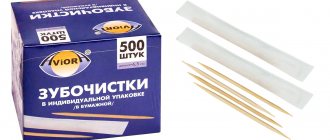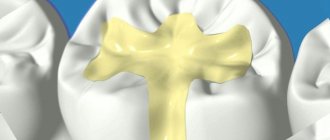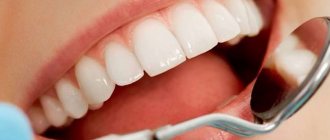Amalgam fillings have been used in dentistry for over 150 years and until recent decades they were the main type of filling in dental offices.
Amalgam is a durable filling material that is created from a metal alloy and mercury. This filling is often called silver, mercury, metal or iron.
Currently, dental clinics continue to install amalgam fillings, as they are reliable and inexpensive. Such fillings last up to 10 years, but modern composite materials are no less durable. In private clinics, amalgam fillings have not been used for a long time.
Are amalgam fillings harmful?
On the Internet you can read many articles about the dangers of amalgam fillings. The authors of some texts indicate that such fillings are a chemical bomb that contributes to the development of incurable diseases.
This topic is also raised in the medical literature, but it indicates only rare allergic reactions that exclude toxicity when using fillings. The greatest risk of mercury entering the human body occurs during the installation and replacement of amalgam fillings. It is for this reason that special amalgams in capsule form are currently used.
The prosecution's case
Dentist-orthopedist Mikhail Ukhanov.
The unaesthetic appearance of amalgam fillings is not their only drawback. Such fillings can be hazardous to health. It is no coincidence that in some European countries the installation of amalgam fillings is prohibited, despite their strength and low cost.
Amalgam filling contains mercury. The melting point of mercury is minus 39 degrees, that is, in the oral cavity, mercury turns into a liquid that easily evaporates. And 80% of the mercury that evaporates from an amalgam filling ends up in the blood. Part of the dangerous substance is excreted from the body, and the other part is deposited in the internal target organs.
Question answer
What is the lethal dose of mercury?
Mercury poisoning often occurs without significant symptoms. But as the toxic substance accumulates in the body, allergic reactions, thyroid diseases, and autoimmune diseases such as systemic lupus and multiple sclerosis may appear.
At the same time, scientists differ in their opinions as to whether the dose of a toxic substance entering the body from a filling is sufficient to cause poisoning.
One reason for this controversy is that the amount of mercury released by a filling depends on many factors, such as the stress the tooth experiences during chewing, the temperature of the food, or whether the filling is damaged. Therefore, it is quite difficult to accurately measure the dose of poison released by an amalgam filling. If a person, for example, is used to clenching his teeth tightly, likes to chew gum or drinks very hot tea, the risk of poisoning will be higher.
However, do not rush to run to the nearest clinic to get rid of old fillings. The fact is that if an amalgam filling is removed incorrectly, the likelihood of poisoning only increases. When the doctor drills out the filling, it heats up and begins to release mercury especially actively.
Abroad, a special protocol has been developed for the safe removal of amalgam fillings. During the procedure, a rubber dam, a special device like a rubber scarf, is placed on the patient’s mouth. It isolates the oral cavity from mercury particles that may enter there when the filling is removed. But such protection, according to European experts, is not enough, because mercury evaporates very quickly, so protection for the nose is also necessary - a kind of “plug” respirator.
Treat or pull out? Why are dental fillings dangerous? Read more
In our country, such a protocol is not widespread; most Russian dentists make do with a rubber dam or work without any protection, believing that the dose of mercury released during the removal of an amalgam filling is not enough to cause poisoning. But if you want to completely protect yourself, before deciding to remove an amalgam filling, ask how the procedure will go. It is advisable that the doctor use at least a rubber dam.
Is it worth changing an amalgam filling?
Some experts believe that amalgam fillings should be completely replaced with modern composite materials. However, any repeated tooth irritation may do more harm than good. Therefore, fillings are changed only in some cases.
Indications for replacing amalgam fillings
- Caries developing around a filling.
- Large fillings (amalgam fillings are not suitable for reconstruction of large cavities).
- Weakened teeth. If only thin walls of the tooth remain, amalgam can cause them to crack.
- Replacement of an amalgam filling for aesthetic reasons, as its color differs from the natural color of the tooth.
There are several situations when it is advisable not to replace amalgam fillings with composite ones. These are usually small fillings that are placed correctly. Any intervention can lead to later complications, so only a doctor can say for sure whether the filling is worth changing.
Main advantages
The material turns out to be very plastic, and therefore easy to apply and simple to work with. After free mercury is released, it hardens on its own, meaning restoration does not require the use of expensive equipment.
What other advantages are there due to the composition:
- high strength and wear resistance, ability to withstand any chewing loads,
- long service life: from 10 years or more with careful care,
- possibility of installation in a damp tooth cavity,
- anti-corrosion properties,
- antibacterial effect,
- preservation of shape and color,
- good penetrating ability: in the presence of zinc in the composition, it penetrates well into small cracks in hard tissues and seals them,
- high radiopacity.
How to remove and replace an amalgam filling
A properly performed amalgam filling replacement procedure is safe for the patient and is always of great importance for the aesthetics of the smile. The procedure is painless and is performed using anesthesia. For the safety of the patient, the oral cavity is covered with a rubber dam, and the nose is covered with a napkin.
Steps to remove and replace an amalgam filling
- The doctor cleans the tooth of plaque.
- The amalgam filling is removed using a carbide bur.
- The remaining fillings are removed with a special dental device.
- The dentist installs a new filling.
Removal and replacement of an amalgam filling is carried out only after an X-ray examination and a dentist’s report.
Important!
Composition of modern amalgams:
- silver (66–73%), provides strength and resistance to corrosion, causes expansion when hardening;
- tin (25–29%), increases the plasticity of amalgam;
- copper (2–6%), gives strength and ensures that the filling adheres to the edges of the cavity, also has antibacterial and anti-corrosion properties;
- zinc (up to 2%), reduces the oxidation of other alloy metals;
- mercury (up to 3%), the main reagent, solvent, causing the formation of amalgam.
Glass ionomer cement
A glass ionomer filling is considered temporary, but it is very durable and adheres tightly to the tooth. It replaced the classic types of dental cements. The material does not allow achieving the required level of aesthetics, therefore it is used as a spacer under the polymer.
The main advantage of glass ionomer cement is the presence of fluoride in its composition. Thanks to this, tooth tissues are strengthened, acquiring increased protection against caries. The material can be self-hardening and light-curing.
Additional Information. The use of glass ionomer cement is widespread in pediatric dentistry. This gentle material is used to install a permanent filling for a child.
Brief historical background
Amalgam is one of the oldest materials used in medicine. It was written about in ancient Chinese manuscripts, and later in Europe a French dentist first used it to fill teeth affected by caries. This happened in 1800. The material was quite plastic, but over time it completely hardened. In those years, these properties made amalgam a sensational discovery in the world of dentistry.
It is also interesting that amalgam is still used in some dentistry, in particular, for specific procedures. Thus, the material is still used for sealing fissures and cervical areas. In addition, it remains in high demand in the West, where, due to its low cost, it gives patients the opportunity to save on expensive treatment.
Use in children
Pediatric dentistry is a special field that requires legibility and care. The main criteria for choosing a method for correcting children's teeth are safety and the possibility of quick and reliable installation.
In the treatment of children's teeth, zinc-eugenol cement is often used, which has the ability to harden even with incomplete removal of saliva. A permanent filling for a child is made from polycarboxylate cement, which has anesthetic and aseptic properties. Glass ionomer cement is also suitable. If the child is willing to sit quietly during treatment, a light-curing material can be used, which is applied in layers and hardens under the influence of a lamp.
Therapy - prices for dental treatment
| NAME OF SERVICE | COST, RUB. |
| Application anesthesia | RUB 100.00 |
| Infiltration anesthesia | RUB 600.00 |
| Conduction anesthesia | RUB 600.00 |
| Rg | RUB 300.00 |
| Trephination of the tooth crown | RUB 300.00 |
| Applying an insulating pad | RUB 500.00 |
| Applying a therapeutic pad | RUB 300.00 |
| Light filling 1st surface | RUR 2,200.00 |
| Light seal 2nd surface | RUR 2,900.00 |
| Partial pinless tooth restoration with light-curing material | RUR 3,700.00 |
| Chemical filling 1st surface | RUB 1,500.00 |
| Chemical seal 2nd surface | RUR 2,200.00 |
| Partial pinless tooth restoration with chemically cured material | RUB 3,000.00 |
| Polishing the filling | RUB 100.00 |
| Polishing a filling placed in another clinic | RUB 500.00 |
| Restoration of a tooth stump for a crown using a chemically cured material | RUB 3,800.00 |
| Restoration of a tooth stump for a crown using light-curing material | RUR 4,800.00 |
| Using an anchor or parapulp pin | RUB 1,000.00 |
| Using fiberglass pin | RUB 1,500.00 |
| Veneer made of light material | RUR 5,000.00 |
| Splinting in the area of the 1st tooth | RUB 1,700.00 |
| Opening of the tooth cavity and medicinal treatment | RUB 500.00 |
| Mechanical and medicinal treatment of the 1st channel | RUB 1,000.00 |
| Repeated medical treatment of the 1st canal for complicated periodontitis | RUB 400.00 |
| Mechanical and medicinal treatment of the 1st difficult canal | RUB 1,700.00 |
| Application of arsenic paste | RUB 300.00 |
| Filling the 1st channel with paste | RUB 1,000.00 |
| Filling the 1st canal with gutta-percha | RUB 1,000.00 |
| Temporary filling of the 1st channel | RUB 500.00 |
| Removing a foreign body from the canal | RUB 2,000.00 |
| Unsealing, mechanical and medicinal treatment of the 1st channel | RUB 1,700.00 |
| Unsealing, mechanical and medicinal treatment of the 1st difficult canal | RUR 2,300.00 |
| Unsealing, mechanical and medicinal treatment of the temporarily sealed 1st channel | RUB 300.00 |
| Removing the anchor pin | 1000.00 rub. |
| Temporary filling | RUB 300.00 |
See the price list for all dental prices
If, when treating caries, the doctor made a mistake or carried out incorrect treatment of the pulp, then caries will definitely begin to grow and progress. This can lead to periodontitis, in which it is necessary to thoroughly and thoroughly clean and seal the dental canals. If this is not done, the infection will go deeper and periodontitis will transform into periostitis. Dentists call “periostitis” inflammation of the periosteum, or the so-called “flux”. If it is not treated in a timely manner, the inflammatory process will affect the entire body and the person may lose a tooth. To reduce the risk of medical errors during treatment and filling of dental canals, it is advisable to carry out such endodontic procedures under a microscope.
When fighting caries, great attention should be paid to preventive measures. This means that the patient must carry out high-quality oral hygiene procedures and undergo regular medical examinations.
It is necessary to destroy caries in the first stages of its manifestation. To do this, it is necessary to use differentiated diagnostic technology. Then the doctor will not have to use a drill. He can do just fine with minimally invasive treatments.
Types of amalgam
The material differs in composition, or rather in the type and concentration of its components. There is another classification based on morphology, that is, according to the external parameters of metal particles. Thus, experts in the field of dentistry distinguish 3 main types of amalgam, depending on the composition:
- silver, which contains less than 6% copper,
- copper, with Cu content in the range of 12-30%,
- high-copper, the copper concentration in which reaches 32-37%.
The material can also be zinc-containing and completely without this component in its composition. The presence of zinc, even in small quantities, simplifies the process of giving the amalgam the desired shape, and also ensures its penetration into the smallest microcracks on the tooth surface.
The material differs in composition
When is it better to choose a different composite?
Dental amalgam has a number of contraindications. Thus, its use is not allowed if the patient has an individual intolerance to the components included in its composition. The material is also not used if the patient has dentures or crowns with metal fragments in his mouth.
The remaining contraindications will be similar to all restrictions that are relevant for filling with any other materials. It should be noted that many refuse this option due to an exaggerated fear of mercury poisoning. The material is only suitable for restoring chewing teeth; for restoring a smile, you should choose a more aesthetic option.
Arguments in favor of our clinics
- A large selection of filling materials, among which the dentist will help you choose the most suitable option for the patient’s specific case and budget.
- Experienced clinic staff guarantees high quality work and durability of the installed filling, subject to proper hygiene.
- We prioritize not only efficiency, but also maximum comfort during the process - all procedures are absolutely painless.
- Prices for installing or removing a filling are affordable and allow a wide range of patients to receive high-level medical service.
Use of ceramics
Ceramics are quite hard and do not change color or size over time. This explains its popularity in dentistry. Filling carious holes with ceramics does not occur immediately in the patient’s mouth. First, impressions are taken of both jaws, then individual inlays are made, which are securely attached to the recesses.
Restoring crowns with ceramic inlays takes longer than any other, but the results are worth it. The inserts stay in place perfectly, and the tooth under such a filling experiences a uniform load. Ceramic materials can have different compositions.









